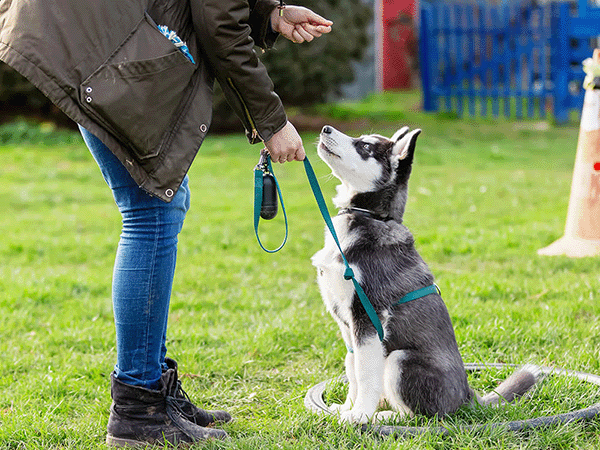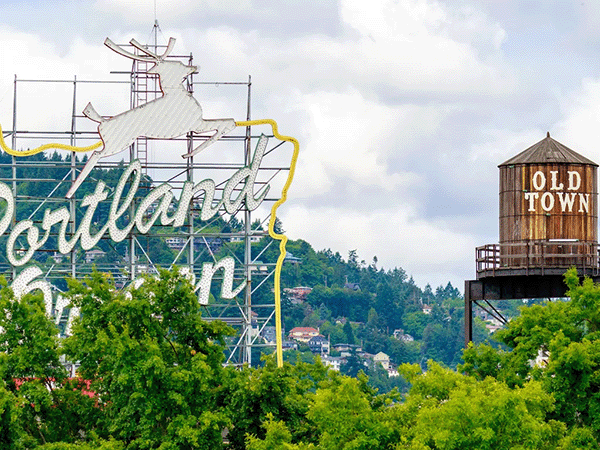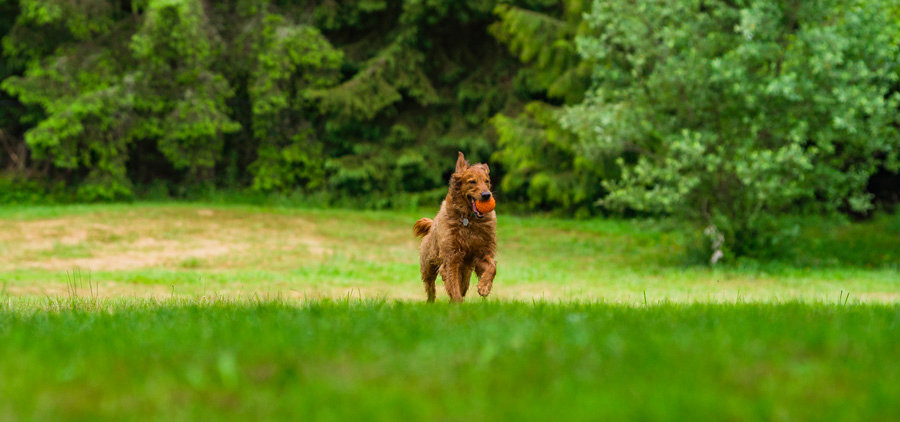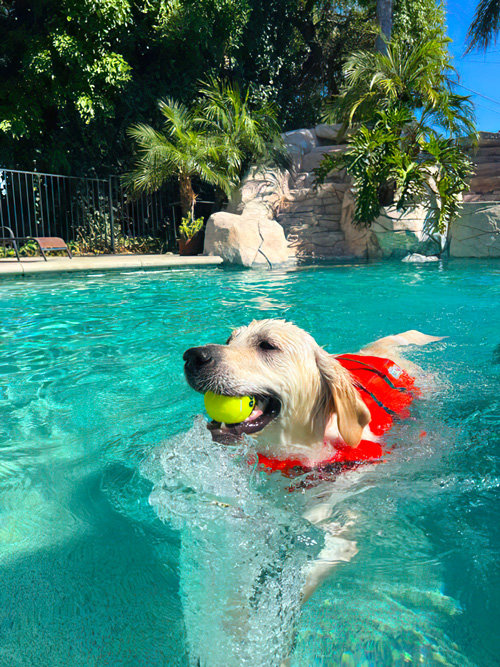What Is a Reactive Dog? A Complete Guide

Is your dog overly excited or fearful around other dogs? Do they bark, lunge, or whine? You might have a reactive dog. Many dog owners face this challenge. Understanding what a reactive dog is is the first step to helping them. This guide explores the common causes of dog reactivity, explains what makes a dog reactive, and offers practical tips and resources. Let's work together to build a stronger bond with your dog and enjoy stress-free walks.
Reactivity is common in dogs. Your dog barking, growling, lunging, or otherwise acting “out of control” on walks or out in public can feel embarrassing — but it’s important to remember that your pup is having a hard time, not trying to give you a hard time.
Sniffspot is committed to providing reactive dog guardians with safe spaces for off-leash exercise as well as up-to-date, trustworthy resources on how to help your sensitive dog feel better about the world around them (and therefore act better, too, in a way that enables you to enjoy more experiences together).
In this guide, we’ll go over what dog reactivity is and isn’t (and what normal dog behavior is), what causes reactivity, and what to do if your dog is showing signs of reactivity.
What is reactivity in a pet dog?
The American Kennel Club defines reactive dogs as “[dogs] that overreact to certain things or situations.” This means that a dog’s reaction to a certain stimulus is excessive or out of proportion with the situation.
Reactivity generally encompasses a range of undesirable aggressive or defensive behaviors (barking, growling, lunging, jumping, pulling, and so on) in situations that typically don’t warrant them in our minds (triggers are behaving normally in a non threatening way) but that are overwhelming or scary to our dogs.
Reactivity is very common: Our own research shows that 75% of dog owners say they have a dog that shows some signs of reactivity.
Key Takeaways
- Reactivity stems from various factors: A dog's genetics, early experiences, and learned associations can all contribute to reactivity. Consider underlying medical conditions as a potential cause and consult your veterinarian if you suspect a medical issue.
- Management and training are crucial for reactive dogs: Identify your dog's specific triggers and employ management strategies to minimize their exposure. Utilize positive reinforcement methods like counter-conditioning and desensitization to modify behavior. Avoid punishment, as it can escalate fear and anxiety.
- Building a supportive network is essential: Seek guidance from a certified professional dog trainer or veterinary behaviorist for a tailored training plan. Connect with other owners of reactive dogs for shared experiences and support. Prioritize your own well-being throughout the process, as managing a reactive dog can be demanding.
What causes dog reactivity?
According to the AKC, “genetics, lack of proper socialization, or a combination of the two can cause reactivity.”
Nature and nurture both play a role in dog reactivity
The “nature versus nurture” debate is at play here. It’s tough to determine what is caused by genetics and what is caused by your dog’s environment, lack of socialization, or potentially traumatic past experiences.
For example, if a dog is born to a mother who is reactive to certain stimuli, he will likely become reactive to the same stimuli. However, it’s difficult to say whether this is straightforward genetics, or whether the dog learned this behavior as a puppy by watching his mother. In a puppy’s early life, especially the first twelve weeks, socialization is critical. If a dog is not properly socialized during this time and is observing a parent with reactive behavior, she might become reactive.
Applied animal behaviorist and author Patricia McConnell writes that dog reactivity can be caused by caused by psychological trauma and compares reactivity to soldiers with PTSD: “Just as a veteran soldier with PTSD can react to a loud noise by throwing herself to the ground, dogs with their alarm systems fixed on HIGH are usually quick to startle to an abrupt noise, or panic when unfamiliar dogs appear.”
The general consensus is that genetics may play a part in dog reactivity — and it’s also likely a conditioned behavioral response. In pet dogs, aggressive behavior on leash can usually be identified as either fear-based leash reactivity or frustration-based leash reactivity.
Genetic Predisposition
Certain breeds are known to be more prone to reactivity than others. Herding dogs, for example, are often naturally more alert and reactive to movement, while some terrier breeds were bred to react to small animals. While genetics may increase the likelihood of reactivity, it doesn’t guarantee it. A dog's environment and experiences play a significant role in shaping their behavior. The American Kennel Club emphasizes that both genetics and learned behavior contribute to reactivity.
Early Experiences and Socialization
A puppy’s early life, especially the first three months, is a critical period for socialization. Positive exposure to various sights, sounds, people, and other dogs during this time can significantly impact a dog's future behavior. If a puppy isn't properly socialized or witnesses reactive behavior in their parent or littermates, they may be more likely to develop reactivity themselves.
Learned Associations
Sometimes, reactivity develops from learned associations. A dog may have a negative experience, such as being startled by a loud noise or rushed by an unfamiliar dog. They might then associate that experience with specific triggers. For example, if a dog is startled by a skateboarder, they might develop a fear of all skateboarders. As Patricia McConnell explains, this can be similar to how humans with PTSD react to triggers. Over time, these learned associations can lead to reactive behaviors.
Fear-based dog reactivity
Fear-based dog reactivity is often caused when nervous or uncertain dogs feel trapped in a certain situation. This causes them to display defensive behaviors that can sometimes be interpreted as aggression (even though the root cause is feeling unsafe, and it’s a bad idea to assume your dog is inherently aggressive because they act defensively).
You can read more about fear aggression in this guide.
Frustration-based leash reactivity
Frustration-based leash reactivity, on the other hand, stems from a dog wanting to interact with something (a person, another dog, an item) that they can’t.
This is common in social dogs who regularly visit dog parks or attend daycare. They love other pets and get frustrated when they aren’t allowed to greet them! That frustration (especially when being held back on a leash) can quickly build into a reactive display. If your dog’s reactivity is limited to when they’re tethered, this article talks about fixing leash reactivity or leash aggression specifically.
Medical Reasons for Reactivity
Sometimes, reactivity isn’t simply behavioral—it’s medical. If your dog suddenly starts exhibiting reactive behaviors, schedule a checkup with your veterinarian to rule out any underlying medical conditions.
Underlying Pain or Discomfort
Reactivity can stem from underlying pain or discomfort. A dog experiencing pain due to an injury or medical condition like arthritis may react defensively to perceived threats, especially if those situations involve being touched or approached in a way that might exacerbate their pain. For instance, a dog with a sore hip might react aggressively if someone tries to pet them near their hindquarters. The Cornell University College of Veterinary Medicine offers resources on managing reactive behavior, including information related to pain management.
Neurological Conditions
Reactive dogs may have underlying neurological issues that affect their behavior and lead to heightened sensitivity to stimuli. These conditions can interfere with a dog's ability to process their environment, resulting in reactive behaviors. For example, a dog with a neurological condition might overreact to loud noises or sudden movements. PetMD provides further information on recognizing the signs of a reactive dog and strategies to help.
Hormonal Imbalances
Hormonal changes, such as those related to thyroid issues or other endocrine disorders, can influence a dog's behavior and contribute to reactivity. These imbalances can affect mood and stress levels, making a dog more prone to react. For example, a dog with a thyroid imbalance might exhibit increased anxiety and reactivity. The American Kennel Club offers guidance on understanding the difference between reactivity and aggression, which can be crucial in determining the root cause of your dog's behavior. Proper diagnosis and management of hormonal imbalances can significantly improve a reactive dog's well-being.
Are certain breeds or types of dogs more likely to be reactive?
The answer is tricky. Some breeds have been bred for specific purposes, such as hunting or herding, and this can influence their behavior.
In addition, over the years, different dog breeds have been maligned for alleged tendencies toward reactivity or aggression (think of all the negative press about Pit Bulls, an umbrella term used for an entire group of different breeds, over the last couple of decades). However, there is no scientific evidence that suggests this is true the way mainstream media often portrays it.
Let’s take a deeper look into dog breed and reactivity.
Some breeds have innate instincts that can be linked to reactivity
We bred certain traits into dog breeds over generations and generations. Two examples: Herders are hyper-aware of their surroundings, and terriers have an intense desire to chase prey. So if your Cattle Dog is barking at quick-moving objects or your Jack Russell keeps lunging after rabbits, there’s a chance their reactivity is caused by unmet genetic drives rather than a lack of socialization! (You can read more about training a herding breed specifically in this article.)
Other dogs are just prone to overarousal, independent of breed
Some dogs also struggle with general overarousal even if they aren’t acting on specific breed traits. If your pet can’t seem to settle down even in familiar environments, triggers out in the world can be like the straw that broke the camel’s back — the final stimulus that puts them all the way over their threshold (which is low already) even though the problem is bigger than that one thing.
Any dog breed can become fearful or frustrated
As mentioned above, much pet dog reactivity can be classified as either fear or frustration based.
In an article about leash reactivity (dogs who are reactive while they are on a leash), Sue Brown, MNM, CDBC, CPDT-KA, states “you cannot predict which dogs will be reactive simply by looking at their breed.” She adds that she is not aware of any studies that look at this question.
While more research is needed, it is likely that a dog’s environment and socialization, not breed, are the key factors in reactivity.
What is not dog reactivity?
It can be tough to know what is and is not reactivity. Remember the definition of reactivity: Dogs that overreact to certain things or situations. To be considered reactive, your dog needs to have certain triggers that are consistent over time — the same stimulus provokes a reaction.
Basically: Your puppy who woofs once or twice when startled? They wouldn’t be diagnosed with reactivity. One who barks, growls, and lunges at every other dog they see out on a walk, on the other hand? They would be considered reactive.
Below are a few behaviors that are not reactivity but are commonly confused with it.
Territoriality or Resource Guarding
Territoriality or resource guarding can sometimes be mistaken for reactivity. While there can be overlap, they aren’t quite the same thing. A reactive dog has specific triggers, meaning the same stimulus provokes a reaction every time. These triggers can vary widely, from other dogs to skateboards to men with beards. Resource guarding, on the other hand, is about your dog protecting something they value. This could be food, toys, a favorite spot on the couch, or even you.
Think of it this way: A reactive dog might bark and lunge at every stroller they see on a walk, regardless of who is pushing it or what’s inside. A dog exhibiting resource guarding behaviors might only growl if someone approaches while they’re chewing a bone. The key difference is the presence of the valued resource. The stroller is always a stroller, but the bone is only valuable when your dog possesses it.
It’s important to note that resource guarding can be dangerous. If your dog feels threatened, they might bite to protect what they see as theirs. If you see signs of resource guarding, consult with a certified professional dog trainer or a veterinary behaviorist. They can help you understand the underlying causes of the behavior and develop a safe and effective training plan.
Rough play
Though rough play can sometimes seem scary — especially if it’s particularly vocal — it’s a normal part of dog interaction. As long as the play is reciprocal (both parties are into it) and each dog takes turns, there’s no cause for concern.
Puppy nipping
Puppies use their mouths to explore. This often involves nipping, especially during play. While this can be annoying or painful, it is not reactivity. Biting is a normal puppy behavior!
What’s more: Remember that puppyhood can be a tumultuous time. Most trainers would not consider any puppy to be properly reactive until they were several months of age and showing more consistent responses to the world around them.
Resource guarding
Dogs will sometimes guard things that are of value to them, such as food (commonly called “food aggression”), bones, or sleeping areas. This may come with behaviors such as growling or snapping and can thus sometimes be erroneously called reactivity.
However, resource guarding is considered a normal behavior for dogs. It absolutely needs to be managed so that it does not escalate to aggression toward the people living in the house with the dog — there are ways to work through it! — but protecting possessions is a normal canine instinct. In general, resource guarding is not considered a reactive behavior.
Pain-Induced Aggression
It’s important to consider that some aggressive behaviors may stem from underlying pain or discomfort. A dog in pain may react aggressively when approached or handled, as they may feel threatened or vulnerable. This can manifest as reactivity, where a dog overreacts to certain situations. For example, a dog with arthritis might growl or snap if you try to pet their hip. They aren't necessarily aggressive, but they're communicating their discomfort. Similarly, a dog with an ear infection might react defensively if you try to examine their ears.
If your dog suddenly starts showing signs of reactivity or aggression, it's crucial to rule out any underlying medical conditions. A visit to the vet is the first step. They can assess your dog's health and determine if pain or discomfort contributes to the behavior. If your dog is experiencing pain, finding a safe and comfortable space for them to relax and recover is essential. Once any medical issues are addressed, you can work with a veterinarian or a certified professional dog trainer to develop a behavior modification plan tailored to your dog's specific needs. For additional resources on dog training and behavior, you can explore Sniffspot's articles on top dog trainers.
Barking or whining when separated from you
This is more accurately classified as “separation anxiety,” not reactivity. You can learn more about separation anxiety in this article and anxiety in general in this one!

How do I know if my dog is reactive?
Do you think your dog is “aggressive” or notice that they bark, lunge, or have other extreme responses to certain stimuli? You might have a reactive dog.
Look for signs of reactivity
Vocalizations
Excessive barking, growling, and whining can be common signs of a reactive dog. For example, does your dog bark for what feels like a long time when he hears a skateboard go by or when the mail carrier comes to the door?
Body language
Body language is also an indicator. Keep an eye on your dog’s body language in different situations. (You can read more about your dog’s body language in this article.)
Notice if your dog shows any signs of anxiety or stress. Some clear indicators could be trying to flee from a stimulus or deciding to charge and lunge at the trigger in hopes of making it go away.
A dog who exhibits stress signals is not automatically a reactive dog — it depends on the exact circumstances. This can be a tricky distinction, but try to determine if the reaction seems like “too much” for the situation. More on this below!
Fixation on Trigger
Reactive dogs might bark, growl, lunge, spin, whine, show tense body language (like a hunched posture), and have trouble focusing. Often, they fixate on what's triggering them. For example, if your dog is reactive to other dogs, they might have a hard time looking away from another dog even when you try to redirect their attention. For more information, check out this helpful article on reactive dog behaviors.
Subtle Stress Signals
Sometimes it’s hard to tell the difference between a reactive dog and a dog who is simply startled or expressing a normal behavior like barking. Look for subtle signs of stress alongside more obvious reactions. Whale eye (where you can see the whites of your dog’s eyes), lip licking, tucked tails, and yawning can all indicate stress or anxiety in dogs. This post on stress signals can help you learn to identify them. A visit to a safe, private Sniffspot can also help your dog relax and de-stress.
Remember that showing signs of stress doesn’t automatically mean your dog is reactive. Context is key! A dog yawning after waking up isn’t necessarily stressed. A dog yawning while also pacing, panting, and whining at the vet, on the other hand, is likely anxious. Consider the whole picture and whether your dog’s reaction seems excessive for the situation.
Intensity of reaction
As we mentioned, remember that not all barking or nervous body language is necessarily dog reactivity. It’s natural for our pets to respond to the world around them! Occasional vocalizations or even larger episodes in particularly scary situations (like being startled by an off-leash dog) can be completely normal depending on your dog’s breed and baseline temperament.
What’s important to think about is if your dog’s reaction seems to match the situation at hand or if it seems over the top. If you try to keep your dog from ever barking again, you’re setting yourself up to fail. It’s a natural canine behavior!
If your dog is continually set off by “small” or common things in the environment, though, then it’s definitely worth considering if they have a form of reactivity and how you can help them feel better about the world.
For example: If your dog exhibits stressed body language when cornered by a wild animal, or if they bark a few times when startled by a small child sprinting at them, that reaction is proportional. If your dog is cowering in fear when the cat walks by, though, or freaking out at the mere sight of a stranger down the street, your dog might be reactive. They are having an intense reaction to something that is not actually a danger to them.
Get in touch with a trainer
When in doubt about whether or not your dog’s behavior is considered canine reactivity, get in touch with a professional trainer. They’ll be able to use their years of experience and continuing education to accurately diagnose — and then help you treat — whatever is going on with your pup.
Is it Reactivity or Excitement?
It’s important to distinguish between excitement and reactivity. Sometimes, what looks like reactivity is simply an over-the-top greeting or playful behavior. A dog might bark and jump when they see another dog, but their body language will indicate a playful, eager state rather than fear or aggression. Think loose, wiggly body, a playful bow, and a relaxed, open mouth. Their tail might be wagging enthusiastically, and their overall demeanor will appear happy and engaged.
Reactive dogs, on the other hand, display stress signals. These signals can include tucked tails, flattened ears, whale eyes (showing the whites of their eyes), lip licking, yawning, and panting. These behaviors indicate underlying anxiety or fear, even if the dog is also barking or lunging. The key difference is the emotional state driving the behavior. An excited dog wants to engage; a reactive dog wants the perceived threat to go away. A reactive dog’s barking is often higher-pitched and more frantic than the barking of an excited dog.
As Sniffspot explains, “A dog who exhibits stress signals is not automatically a reactive dog — it depends on the exact circumstances.” Consider the context. Is your dog reacting proportionally to the situation? A bark at a sudden loud noise is normal. Continuous barking and lunging at a dog across the street, accompanied by stress signals, is more likely reactivity. If you’re unsure, consulting a qualified dog trainer can provide personalized guidance. Finding safe, controlled environments for your dog to socialize and exercise, like those offered on Sniffspot, can also be a valuable tool in managing reactivity.
What should I do if my dog is showing signs of reactivity?
How to train through your dog’s reactivity is a huge topic. We’ve put together a separate beginner’s guide with everything you need to know to get started! Below are the key points to keep in mind.
Try to remain calm
First things first: Don’t panic!
As we stated above, many people live with reactive dogs. You can live a full life with a reactive dog — and your reactive dog can have a full life, too.
Figure out what causes your dog’s reactivity
Understand your dog’s triggers and emotions
Spend some time thinking about why your dog barks, growls, and lunges at certain things. Really observe your dog. When are they calm and showing relaxed behavior? When are they reactive? Your pup may have a trigger that’s obvious (mail carriers, people with beards, etc) or it may be harder to spot. (Maybe she wildly barks sometimes and you don’t know why — in this case, try your best to listen, watch and get to the root of it.)
Questions to ask yourself about your dog’s reactivity
- In what situations is your dog most likely to react? Does a trigger have to be moving in a certain way (directly approaching versus passing on the other side of the street, for example)?
- How close does a trigger need to be before your dog barks, lunges, growls, or otherwise reacts at it? This is referred to as their threshold distance. If the trigger is farther away than this limit, they’re under threshold and able to take treats normally, sniff the environment, and respond to you with loose body language. Once it breaks their “bubble,” they go into a panicked fight-or-flight mode.
- Is your dog’s reactivity limited to when they’re on a leash, or does it happen regardless of where they are (loose in the yard, in your home, etc)?
- Is your dog a social butterfly with their triggers outside of a certain context, or do they always react?
- Does your dog seem afraid or merely over aroused?
Pay attention to your dog’s body language
As mentioned in the above section on how to know if your dog is reactive, watch for signs of stress in your pup, such as lip licking, facial tension, whale eye (when a dog turns their head but keeps their eyes on you, showing a lot of the whites of their eyes), shaking, or freezing. If you notice your dog showing these signs, note the situation and environment and see if you can get to the bottom of what’s causing them. (You may have to do this several times to be able to notice a pattern.)
You might never have clear answers about what causes your dog’s reactivity
Understanding the root cause of your dog’s reactivity can be difficult — and maybe even impossible for some pets. It’s worth spending some time thinking about it, but don’t dwell if you (or even your trainer, a behavior professional) can’t fully figure it out. Try to make peace with the ambiguity and commit to treating your dog’s behavior.
Meet your dog’s basic needs and keep tabs on their health
It’s always a good idea to evaluate your reactive dog’s basic needs before focusing on specific training situations. Even if your dog’s reactivity is driven by more than a treatable health or fulfillment problem, making sure their needs are met will still help you maximize your training success.
Physical health problems can exacerbate reactivity
Canines are great at hiding discomfort. If your dog is reacting when being touched by people or playing with other dogs — especially if they’re suddenly sensitive in situations they used to tolerate well — there’s a good chance they’re in pain.
Consider Veterinary Consultation
Because physical health problems can exacerbate reactivity, it’s always a good idea to consult your veterinarian. Canines are great at hiding discomfort. If your dog is reacting when being touched by people or playing with other dogs—especially if they’re suddenly sensitive in situations they used to tolerate well—there’s a good chance they’re in pain. Even seemingly minor issues, like a urinary tract infection, can make dogs grumpy and more reactive. It’s worth ruling out an underlying medical condition before focusing on behavioral modification.
Your vet can also prescribe medication to help manage your dog’s reactivity. While medication isn’t a magic bullet, it can lower your dog’s overall stress levels, which can make training more effective. Think of it like talk therapy for humans—it’s a tool to help your dog cope, not a cure. Many owners find that a combination of medication, training, and environmental management is the key to success with reactive dogs.
Provide enrichment to help fulfill your dog
At its simplest, enrichment provides animals with opportunities to satisfy their innate instincts. Common enrichment activities usually give our dogs the chance to safely dig, sniff, and emulate their predatory behavior sequence (searching, stalking, chasing, fighting, celebrating, and consuming) without causing harm to or disrupting the communities we live in.
You can read more in our Comprehensive Guide to Canine Enrichment article. Get their brains going!
Safe and Enriching Spaces on Sniffspot
Finding safe and enriching spaces for your reactive dog can be a game-changer. A predictable environment where your dog can relax and engage in natural behaviors is key for building confidence and reducing reactivity triggers. That’s where Sniffspot comes in.
Sniffspot offers private dog parks that provide a controlled and secure environment for reactive dogs to explore and play without the stress of unpredictable encounters with other dogs or people. These spaces allow you to tailor the experience to your dog's specific needs, whether it's a quiet, secluded spot or a larger area with stimulating features.
Many Sniffspot hosts understand the challenges of dog reactivity and offer amenities specifically designed for reactive dogs, such as separate entrances and exits, visual barriers, and ample space between bookings to minimize potential stressors. This personalized approach can make a world of difference in helping your reactive dog feel safe and comfortable.
Beyond simply providing a safe space, Sniffspot can also be a valuable tool for enrichment. Dog water parks, for example, offer a fun and engaging way for dogs to cool off and exercise, while hiking trails on Sniffspot provide opportunities for sniffing and exploring new environments. Even a simple, fenced-in yard can become an enriching experience with the addition of puzzle toys, scent games, or a digging pit.
By combining the safety and control of a private space with enriching activities, Sniffspot can help you create positive experiences for your reactive dog, build their confidence, and reduce their overall reactivity. It's a win-win for both you and your furry friend.
Take care of yourself as your dog’s guardian, too
Living with a reactive dog can be overwhelming — and there’s no shame in admitting that. It’s okay if you’re tired. It’s okay if you miss a training session here and there. It’s okay if you sometimes feel jealous of other dogs and owners who don’t have to worry about the things you’re constantly keeping track of.
Take time to practice self care. You have to fill your own cup before you’re able to give your dog what they need! There will inevitably be setbacks in training your reactive dog — but together you can create more positive associations, as long as you show yourself grace.
Use management strategies to prevent reactive behavior while you work on training your dog
Management is an important part of helping your reactive dog. The more frequently your pet practices their undesirable behaviors in a heightened emotional state, the deeper they ingrain those habits. It’s important to prevent as many reactions as possible so your training can be successful!
Once you know your dog’s triggers, the good news is that you can manage them (to some degree). Take note of everything in and around your home that you can control. Get creative with your dog’s environment to minimize what triggers them.
Just a few management examples to minimize your dog’s exposure to triggers:
- Carefully consider when you go to an environment and whether it will be too busy for your reactive dog to feel comfortable. It’s smart to avoid places with many off-leash dogs, young kids, or other common triggers, especially early on in your reactivity training plan.
- Put on white noise for dogs who bark when they hear a car or person outside.
- Cover your windows with film or close the blinds to prevent your dog from barking at triggers outside your living room or office windows throughout the day. You can also use household objects as visual barriers.
- Drive to a quieter walking route rather than trying to stay in your immediate neighborhood if it’s too overwhelming.
- Don’t feel guilty about turning around when you see a trigger if you aren’t prepared to train through it. Remember management is your friend!

When management fails, get out of the situation
If you are surprised by a trigger, try to get out of the situation as gracefully as possible. For example, if you are surprised by another dog on a walk and your dog is reactive to other dogs, this might look like making a u-turn or crossing the street. Your exact exit strategy will be different depending what the trigger is.
The important things to remember are that you want to get away from the trigger safely and you do not want to punish your dog (more on that below).
If your dog does react, remember it can take a long time for their nervous system to completely recover. Take it easy for the next few days and up your management game!
Start tackling specific reactivity scenarios
We’ve covered a lot of reactivity treatment foundations. Now for the nitty gritty: What does the actual training to address your dog’s reactivity look like? There are a range of training techniques, methods, and set ups to help your reactive dog feel calmer around their triggers. Most of them involve creating neutral or positive experiences to change their underlying emotions. This process is called behavior modification or behavior rehabilitation.
We’ve compiled a full list in this reactivity training article with comprehensive steps to follow, but below are two key concepts to understand.
Desensitization
Desensitization involves getting our dogs used to their triggers slowly, in small doses that don’t put them over threshold. While it can be difficult to implement in the “real world” (public environments are often unpredictable and we can’t always decide how far away our dogs are from their triggers) it’s a valuable technique in controlled situations. Distance, intensity and duration matter.
According to the VCA, desensitization means “the gradual exposure to situations or stimuli that would bring on the undesirable behavior, but at a level so low that there is no negative response.” Desensitization and counterconditioning go hand in hand.
Counterconditioning
Counter conditioning (CC) is your best friend when you have a reactive dog. What is it? Counter conditioning means “changing the pet’s emotional response, feelings or attitude toward a stimulus,” according to the VCA.
Counter conditioning is the process of pairing something scary or overwhelming (your reactive dog’s triggers) with something positive (like their favorite treats or toys) to ultimately change their conditioned emotional response over time. CC can be incredibly helpful when working with reactive dogs — but it’s important to be aware of your timing! If you feed your dog before they notice their trigger, you might accidentally teach them that “good things predict scary things” instead of the other way around. You also have to keep up CC consistently or undesirable emotions (and their associated behaviors) can return.
What counter conditioning might look like in practice
Here are a few steps to begin counterconditioning your dog’s triggers. First, you’ll need lots of high value treats. Take your dog (and your treats) to an area with the dog’s trigger (or where the trigger is likely to appear). Once the trigger appears and the dog clocks it (e.g. you can see the dog observing the trigger, but not yet reacting to it), begin generously rewarding the dog with the high value treats.
An example: perhaps you’re out on a walk with a dog who is reactive to skateboards. You hear a skateboard in the distance, and see your dog’s ears prick up, observing the sound. Now is a great time to reward the dog with the high value treats. The goal here is to change the dog’s association from “skateboarders = bad and scary” to “skateboarders = treats are coming.”
The process will look different depending on the dog’s triggers, but that is the basic idea. It is very important to start small and go slowly. As with any training process, counterconditioning is likely to take a while, and you will have to do it multiple times across many different sessions. Be patient and celebrate victories, even if they seem small!
Working with a Certified Professional
Finding a Certified Dog Trainer or Veterinary Behaviorist
If your dog shows signs of reactivity, consider working with a certified professional. A certified dog trainer or, even better, a veterinary behaviorist specializing in reactivity can be invaluable. They can help you identify your dog’s specific triggers, understand the underlying causes of their behavior, and develop a tailored management and training plan. Sniffspot can help you find qualified trainers near you.
Benefits of Professional Guidance
Working with a certified professional offers several benefits. They bring expertise in canine behavior and learning theory, providing structured guidance and support. A professional can also offer objective observations about your dog’s behavior, which can be difficult for owners to assess on their own. Plus, they can teach you effective training techniques and help you troubleshoot any challenges you encounter. Cornell University’s College of Veterinary Medicine offers more information on managing reactive behavior.
Medication as a Management Tool
Discuss Medication Options with Your Veterinarian
In some cases, medication can be a helpful tool in managing reactivity, especially if anxiety or other underlying conditions contribute to the behavior. It’s important to discuss medication options with your veterinarian. They can assess your dog’s individual needs and determine if medication is appropriate. The American Kennel Club discusses the difference between reactivity and aggression, which is an important distinction to understand when considering medication.
Combining Medication with Behavioral Training
Medication is most effective when used in conjunction with behavioral training. It can help reduce your dog’s anxiety levels, making them more receptive to training and behavior modification techniques. Think of medication as a support system, not a cure-all. It can help create a calmer state of mind for your dog, allowing them to learn and adapt more easily. Learn more about medications used in dog behavior therapy. PetMD offers insights into what a reactive dog is and how to help.
What not to do if you have a reactive dog
You should never punish your dog for reactivity. Many people are tempted to do this in an attempt to “correct” the behavior — but dog trainers agree it only makes things worse in the long run. It can instill more fear in your dog and does not deal with the root of their reactivity.
Though it can be difficult to resist the urge to punish in the moment, keep in mind that positive reinforcement is a much more effective strategy. Punishment will only degrade your relationship with your dog.
Avoid Punishment or Force-Based Methods
You should never punish your dog for reactivity. Many people are tempted to do this in an attempt to “correct” the behavior — but qualified dog trainers agree it only makes things worse. It can instill more fear in your dog and doesn’t address the root of their reactivity. Learn more about reactivity in dogs here.
Though it can be difficult to resist the urge to punish in the moment, keep in mind that positive reinforcement is a much more effective strategy. Punishment will only damage your relationship with your dog.
Don't Flood Your Dog with Triggers
Managing your dog’s environment is an important part of helping your reactive dog. The more frequently your pet practices their undesirable behaviors in a heightened emotional state, the more they reinforce those habits. It’s important to prevent as many reactions as possible so your training can be successful! This article on reactive dogs explains why.
Once you understand your dog’s triggers, you can manage them. Take note of everything in and around your home that you can control. Get creative with your dog’s environment to minimize their exposure to triggers. For example, Sniffspot can be a great resource to find safe and controlled environments for your dog to practice de-stressing and relaxing.
Further reading and learning
There are countless great resources for how to live with and train a reactive dog! Here are a few that we like.
Sniffspot blogs on canine reactivity
We have an entire blog category devoted to dog reactivity and related problem or unwanted behaviors. One of our primary goals is to be a welcoming community for reactive dogs — that’s why we have specific rules (like gaps between arrivals and transparency about other animals within view) to keep all Sniffpots safe.
Here are a few specific articles:
- How to Train a Reactive Dog: A Beginner’s Guide for everything you need to know to get started implementing a training program for your reactive dog
- How to Socialize Your Reactive Dog for help on how to give your fearful, frustrated, or otherwise reactive dog positive experiences with other dogs and people
- Dog Reactivity Chart for help understanding the current level of reactivity your dog shows in different moments
Other training resources on dog reactivity
- Trainer Patricia McConnell’s guide to how to handle reactive dogs
- CARE For Reactive Dogs is a whole website dedicated to methods and gear for dealing with a reactive dog
- Suzanne Clothier reactive dog training scenario set up
- Trainer Alice Tong’s engage-disengage game (specific to leash reactivity, but can be applied to other types of reactivity as well)
- The VCA’s guide to counterconditioning and desensitization
Good luck, and remember: you’re not alone. When in doubt, get in touch with a professional force free trainer you trust. And know you can always bring your dog to a Sniffspot for some playtime!
Trainer Review of This Article
There is so much misinformation out there, we want to make sure we only provide the highest quality information to our community. We have all of our articles reviewed by qualified, positive-only trainers.
This is the trainer that reviewed this article:
Shannon Finch
AnimalKind Training
M.Ed. Humane Education
Karen Pryor Academy Certified Training Partner
Certified Tellington TTouch and TTEAM Practitioner
Sniffspot’s Proprietary Survey Statistics
Sniffspot Research 2023, n = 4,092

Related Articles
- How to Train a Reactive Dog: Beginner’s Guide + Tips
- Dog Reactivity Training | When Your Dog Reacts to Other Dogs
- Definitive Guide: What is Dog Reactivity, Percentages and Symptoms
- Dog Barrier Reactivity and Frustration Training | Sniffspot
- Where to Bring Your Reactive Dog for Training and Exercise
Frequently Asked Questions
Is my dog reactive if they bark at the mail carrier?
Not necessarily. It's normal for dogs to bark at unfamiliar sounds or people approaching their territory. Reactivity is about the intensity and frequency of the reaction, not just barking itself. If your dog barks excessively at every mail carrier, every delivery person, or every unfamiliar sound, and shows other stress signals, it might be reactivity. If it's a few barks and then they settle down, it's likely normal territorial behavior.
My dog is reactive on leash, but fine off-leash. What's going on?
This is called leash reactivity, and it's fairly common. On-leash, dogs might feel restricted and unable to flee from perceived threats, leading to a heightened reactive response. They might also be frustrated at not being able to greet other dogs or investigate interesting smells. Off-leash, they have more freedom and control, which can reduce their anxiety and reactivity.
How can I find a qualified trainer to help with my reactive dog?
Look for certified professional dog trainers or veterinary behaviorists who specialize in reactivity and use positive reinforcement methods. Avoid trainers who advocate punishment or dominance-based techniques. Sniffspot maintains a list of recommended trainers, and you can also ask your veterinarian for referrals.
Are certain breeds more prone to reactivity?
While some breeds have been bred for traits that might make them appear more reactive (like herding dogs being alert to movement), any dog can develop reactivity. Genetics might play a small role, but early socialization, experiences, and learned associations are much more significant factors.
I feel overwhelmed by my dog's reactivity. What can I do?
It's completely understandable to feel overwhelmed. Caring for a reactive dog can be challenging. Remember to prioritize self-care and seek support from other reactive dog owners or online communities. Finding safe, controlled environments like Sniffspot can also make a big difference in reducing stress for both you and your dog.
Most recent articles
Related articles
Top dog guides per area
Dog training guides

Dog Food Aggression: Why You Shouldn't Punish It
Does your dog ever growl when you walk by their food dish? Maybe they get possessive of treats, carrying them far away and giving you side-eye when you start to approach — or snarling at your other pets or children if they get too close.

Best Dog Fields in the US: 25+ Wide-Open Spaces for Your Pup to Run Free
The best dog fields in the US offer something that traditional enclosed parks simply can't match: acres of open space where your pup can truly stretch their legs and run at full speed. From Colorado's 470-acre prairie meadows to Tennessee's award-winning "Outback," these wide-open spaces allow dogs to roam, explore, and exercise naturally while engaging instincts that cramped urban parks suppress.

The Ultimate Guide to Scent Training for Dogs
Your dog's nose is an amazing tool. Did you know they have 40 times the olfactory receptors than humans? Scent training for dogs taps into this superpower, turning everyday moments into exciting sniff-fests. It's enriching for all types of dogs – reactive, shy, or simply adventurous. Ready to explore the world of scent work for dogs? Let's get started.

Service Dog Training Costs: DIY vs. Pro
More than 80 million Americans rely on their service dogs to help them navigate the world. Task-trained assistance animals perform a huge range of life-changing—in many cases, life-saving—services: These dogs act as eyes for visually impaired handlers, provide mobility support, alert to seizures and blood sugar crashes, interrupt anxiety attacks, remind their people to take medications, and so much more.

How to Deal With Puppy Potty Training Regression
You thought those dreaded middle-of-the-night potty breaks were over. You were finally free from cleaning up puppy puddles. Then, suddenly, your furry friend starts having accidents again. It's frustrating, right? This puppy potty training regression is more common than you think. Don't worry; we'll help you get your pup back on track. We'll cover the common causes, offer practical solutions, and give you actionable steps to tackle this challenge together.

Dirty Dog Syndrome: Causes, Solutions, and Prevention
It's a cringe-worthy moment every dog owner dreads: your furry friend chowing down on something truly disgusting. If your dog has a penchant for poop, you're dealing with coprophagia. It's more common than you think, and thankfully, often manageable. This article explores the reasons behind dirty dog syndrome, from instinct to learned behavior. We'll also give you practical tips to help break this unpleasant habit.

How to Train Your Rescue Dog: A Complete Guide
* All Sniffspot articles are reviewed by certified trainers for quality, please see bottom of article for details *
Dog enrichment guides

Best Dog Water Parks in the US: 15+ Amazing Splash Destinations for Your Pup
Do you have a water-loving dog looking to burn some energy? There are countless dog parks to visit throughout our country — but some of them become far too hot in the midday sun to be safe for your pets to play. That’s why we’ve put together a list of some of the best dog water parks throughout the United States! At these locations, your pup can frolic, splash, and swim to their heart’s content.

Best Dog Fields in the US: 25+ Wide-Open Spaces for Your Pup to Run Free
The best dog fields in the US offer something that traditional enclosed parks simply can't match: acres of open space where your pup can truly stretch their legs and run at full speed. From Colorado's 470-acre prairie meadows to Tennessee's award-winning "Outback," these wide-open spaces allow dogs to roam, explore, and exercise naturally while engaging instincts that cramped urban parks suppress.

Best Toys for Herding Dogs: Keeping Your Pup Happy & Engaged
Herding dogs are amazing, intelligent companions. But that also means they need more than just a simple game of fetch. Finding the right toys for herding dogs is key to keeping them happy and stimulated. This article explores some of the best toys for herding dogs, including options specifically for breeds like Border Collies and Australian Shepherds. We'll help you discover the perfect herding toys for dogs to tap into their natural instincts and keep them entertained for hours.

Tough Dog Toys for Aggressive Chewers: A Practical Guide
Does your dog destroy every toy you give them? Is your house littered with the remnants of plush toys? Are you tired of wasting money on "indestructible" dog toys for aggressive chewers that don't last? Then this post is for you. We'll cover everything you need to know about finding the best dog toys for aggressive chewers, so you can finally give your pup something safe, durable, and fun.

Daily Exercise Calculator: How Much Exercise Does Your Dog Need?
Everyone knows dogs need exercise, but how much is enough? Walks are great, but creating a truly balanced fitness plan means understanding your dog's specific needs. This post helps you develop a daily exercise calculator for your dog, considering breed, age, and lifestyle. We'll cover fun activities, understanding exercise intensity, and recognizing when your pup has had enough. Let's create a plan that keeps your dog happy and healthy!

Complete Guide To Herding With Dogs
* All Sniffspot articles are reviewed by certified trainers for quality, please see bottom of article for details *

Dog Enrichment Activities: The Ultimate Guide
Ever feel like your dog is restless or bored? They may be getting enough exercise, but still need more. That's where enrichment activities for dogs come in. Giving your dog opportunities to sniff, explore, and problem-solve can make a world of difference. Whether you have a puppy, adult, or senior dog, enriching their environment is key for their well-being. Let's explore how to add cognitive enrichment for dogs, even tailoring activities to your dog's breed with breed specific enrichment and fun enrichment games for dogs.
Dog reactivity guides

Rottweiler Aggression: Truth vs. Myth
Many dogs have gotten a bad reputation over the years for being "dangerous breeds." Rottweilers are among them. Like pit bulls and other large, blocky-headed types of dogs, these powerful and beautiful animals are often assumed to be aggressive.

Best Dog Fields in the US: 25+ Wide-Open Spaces for Your Pup to Run Free
The best dog fields in the US offer something that traditional enclosed parks simply can't match: acres of open space where your pup can truly stretch their legs and run at full speed. From Colorado's 470-acre prairie meadows to Tennessee's award-winning "Outback," these wide-open spaces allow dogs to roam, explore, and exercise naturally while engaging instincts that cramped urban parks suppress.

What Is a Reactive Dog? A Practical Guide for Owners
Does your dog suddenly transform into a barking, lunging Tasmanian devil on walks? It's stressful for both of you. If this sounds familiar, you might have a reactive dog. Understanding what is a reactive dog is the first step to calmer walks. We'll explore the common triggers and give you actionable strategies to manage and modify this behavior. Let's turn those stressful walks into enjoyable outings.

How to Socialize a Reactive Dog: A Step-by-Step Guide
Does your dog display reactivity to other pets or people? Maybe they’re a new rescue pup and are still settling into your home. Or they were sick growing up, so you missed their critical socialization period. Possibly they’ve had a bad experience after being raised as a normal puppy.

What Is a Reactive Dog? A Complete Guide
Is your dog overly excited or fearful around other dogs? Do they bark, lunge, or whine? You might have a reactive dog. Many dog owners face this challenge. Understanding what a reactive dog is is the first step to helping them. This guide explores the common causes of dog reactivity, explains what makes a dog reactive, and offers practical tips and resources. Let's work together to build a stronger bond with your dog and enjoy stress-free walks.

9 Best Online Communities for Reactive Dog Parents
Does your dog's reactivity make walks stressful? You're not alone. Many dog owners face similar challenges. This guide offers practical advice and support for managing reactivity, including finding the best online dog training for reactive dogs. We'll connect you with reactive dog support groups, share training tips, and explore resources like the best dog training app for reactive dogs. Let's build a stronger bond with your dog, together.
* All Sniffspot articles are reviewed by certified trainers for quality, please see bottom of article for details *
How To Groom a Reactive Dog
* All Sniffspot articles are reviewed by certified trainers for quality, please see bottom of article for details *
Sniffspot community guides

The State of Public Dog Parks Across the United States
From 2009 to 2020, there was a 40 percent increase in the development of public dog parks. Designated spots for canine exercise have become commonplace in every major city in North America — many pet owners won’t even consider renting an apartment that doesn’t have its own fenced-in pet area for their canine companions.

Best Dog Fields in the US: 25+ Wide-Open Spaces for Your Pup to Run Free
The best dog fields in the US offer something that traditional enclosed parks simply can't match: acres of open space where your pup can truly stretch their legs and run at full speed. From Colorado's 470-acre prairie meadows to Tennessee's award-winning "Outback," these wide-open spaces allow dogs to roam, explore, and exercise naturally while engaging instincts that cramped urban parks suppress.

How This Family is Affording Their Dream Property Through Renting it Hourly to Dogs
Thousand Oaks, California has been a safe haven for Sniffspot host, Jen, since childhood. Having grown up in busy Santa Barbara, Jen, an introvert from an early age, would seek out solitude and serenity away from tourists attractions and droves of people visiting from elsewhere. “My grandparents own 60 acres about a 30 minute drive from here, and I grew up spending every summer and every holiday visiting them on the ranch,” Jen explained. “In Santa Barbara, we wouldn't go to the beach on the weekend because that's where everybody was, so you'd find places off the beaten path where the tourists weren't. For me, the ranch was just my happy place.”

Host Tips: Ellen K. What Makes Sniffspot Successful for Me
Ellen is the host of Country Pasture Getaway, one of Sniffspot's most popular sniff spots. She has taken the time to write up the lessons she has learned about how to be a great sniff spot host.

How this Oregon Farmer is Making a Business From Renting Her Land to Dogs
Just 20 minutes outside of the busy city of Portland, Oregon, and settled right on the banks of the Columbia River, you’ll find what countless visitors have flocked to the area in search of – mountain views, crisp, clean air, and running water for miles. What you might not expect to find, however, is a hidden oasis designed just for dogs and their people, owned and operated by a farming couple and enjoyed by visitors on two legs, and four.

Host Tips: Fran T. Providing Great Guest Service at our Spot
Fran is the host of Ranch Setting, one of Sniffspot's most popular spots. She has taken the time to write up the lessons she has learned about how to be a great Sniffspot host.

How Sniffspot Helped a Nervous Rescue Work Through His Fears and Change His Family’s Life
This is the story of a family and dog rescuing each other.
Top dog trainers in the US

The Best Dog Trainers in the United States of 2025
This is a list of the top dog trainers in the United States, based on votes from the Sniffspot community and the general public.
The Best Dog Trainers in Seattle, WA of 2025
This is a list of the top dog trainers in Seattle, WA, based on votes from the Sniffspot community and the general public.
The Best Dog Trainers in Portland, OR of 2025
This is a list of the top dog trainers in Portland, OR, based on votes from the Sniffspot community and the general public.
The Best Dog Trainers in Los Angeles, CA of 2025
This is a list of the top dog trainers in Los Angeles, CA, based on votes from the Sniffspot community and the general public.
The Best Dog Trainers in New York, NY of 2025
This is a list of the top dog trainers in New York, NY, based on votes from the Sniffspot community and the general public.
City dog parks guides

Top 10 Indoor Dog Parks: A US Guide
Looking for a space to play with your dog no matter what the weather’s like outside? Look no further than our list of the best indoor dog parks in the United States! These climate-controlled spaces are growing in popularity as pet ownership increases throughout the country. As a bonus, many of them also offer dog training, boarding, grooming, or daycare services on the premises.

Best Dog Fields in the US: 25+ Wide-Open Spaces for Your Pup to Run Free
The best dog fields in the US offer something that traditional enclosed parks simply can't match: acres of open space where your pup can truly stretch their legs and run at full speed. From Colorado's 470-acre prairie meadows to Tennessee's award-winning "Outback," these wide-open spaces allow dogs to roam, explore, and exercise naturally while engaging instincts that cramped urban parks suppress.

Best Dog Parks in the US: Ultimate Guide to Public & Private Off-Leash Adventures
Is your pup giving you those pleading "let me run free" eyes? Whether you're a new dog parent or a seasoned pro looking for fresh adventures, finding the perfect off-leash paradise for your furry friend can feel ruff! From sun-soaked California beaches where your water-loving lab can make a splash to mountain trails in Vermont where your adventure buddy can chase every scent, we've sniffed out the 15 best dog parks across America.

Dog Parks Near Me: Las Vegas Edition
Looking for the perfect dog park near me in Las Vegas? You're in luck! This guide explores all the best options for your pup, from public dog parks to private dog parks near me on Sniffspot. We'll help you find the ideal spot for playtime, socializing, and fresh air. Plus, we'll cover essential etiquette and safety tips to ensure a happy visit for everyone. Get ready for some tail-wagging fun!

Top Sniffspot Locations: Find the Perfect Dog Park
Looking for the perfect dog park? Whether you need a wide-open public space or a private, fenced-in spot, this guide will help you find the best dog parks across the US. We'll cover top-rated public parks, the perks of private dog parks, and even explore Sniffspot locations – giving your pup a safe and fun place to play. Ready to find your dog's new favorite spot? Let's go!

Sniffspot: Portland's Best Private Dog Parks
Ready to discover Portland's best dog parks? Whether you're looking for a public park or the unique experience of a private Sniffspot, this guide has you covered. We'll help you find the perfect spot for your pup, with tips on what to bring, how to prepare, and even understanding dog body language. Plus, we'll explore some top Portland dog parks, including public and Sniffspot options, so you can plan your next dog-friendly adventure in the City of Roses.
Portland Dog Parks: Public & Private Options
This page is about public city dog parks and also includes Sniffspot private dog parks. Sniffspot is the largest network of private dog parks for rent in the world!
Small Dog Park Guide: Tips for Finding the Perfect Spot
Finding the perfect dog park for your small breed can be ruff! Big dog parks can be overwhelming, even dangerous, for little pups. This comprehensive guide helps you sniff out the best small dog parks for your pint-sized companion, covering everything from essential safety checklists to top recommendations for small dog parks across the US—including both public spots and private dog parks.
Dogs breeds

German Shepherd Dogs: Insights From Real Dog Owners
The German Shepherd Dog (GSDs) are known for their intelligence, loyalty, and striking appearance. They're also incredibly versatile, excelling as working dogs and devoted family companions. This guide covers everything you need to know about GSDs, from understanding their unique traits and rich history to practical advice on training and care. So, whether you're a seasoned GSD owner or just starting your research, let's explore this remarkable breed together.

Best Dog Fields in the US: 25+ Wide-Open Spaces for Your Pup to Run Free
The best dog fields in the US offer something that traditional enclosed parks simply can't match: acres of open space where your pup can truly stretch their legs and run at full speed. From Colorado's 470-acre prairie meadows to Tennessee's award-winning "Outback," these wide-open spaces allow dogs to roam, explore, and exercise naturally while engaging instincts that cramped urban parks suppress.

Labrador Retriever: Ultimate Guide by Owners
Discover the Labrador Retriever, a breed celebrated for its playful nature, affectionate temperament, and trainability. Labradors are known for their friendly demeanor and adaptability, making them perfect family companions and versatile working dogs. As one of the most popular types of retrievers, Labs are ideal companions for various lifestyles and are recognized by the American Kennel Club (AKC) as an excellent breed for families.

Golden Retriever Advice: The Complete Owner's Guide
Golden Retrievers: they're gorgeous, playful, and incredibly popular. But before you welcome one into your home, you need the right golden retriever advice. This guide draws on the wisdom of nearly 10,000 Golden Retriever owners, offering practical tips for caring for these affectionate dogs. From understanding their high energy levels to mastering grooming and training, we'll cover everything you need to know. So whether you're already a devoted Golden parent or just starting your research, get ready to learn how to give your furry friend the best possible care.

American Staffordshire Terrier: Your Complete Guide
Think American Staffordshire Terriers are tough? Think again. While their muscular build might intimidate some, these dogs are known for their playful and loyal personalities. This guide draws on the experience of nearly 10,000 AmStaff owners to reveal the truth about this often misunderstood breed. Want to learn more about caring for an American Staffordshire Terrier? You're in the right place.

Australian Shepherd Facts: Breed Info & Care Guide
Discover the Australian Shepherd, an AKC breed celebrated for its trainable, playful, and affectionate nature. Despite its name, the Australian Shepherd is actually a native breed to the United States, originally developed to breed on farms and ranches. Considered a medium dog, Australian Shepherds were bred for herding beginning in the 1950s. As one of the high-energy breeds, Aussies are known for their boundless energy and need for regular exercise, including aerobic exercise.

Essential Husky Facts for Owners: Breed Guide
Discover the Siberian Husky, a breed celebrated for its curious, intelligent, and loyal nature. Considered a medium-sized dog, Siberian Huskies were originally bred in Russia for sledding, beginning in the early 20th Century. Today, they're one of the most popular active breeds in North America.





























